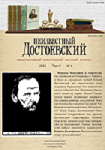Роман Ф. М. Достоевского «Преступление и Наказание» в контексте Священной истории: Авраам, Христос, Магомет
F. M. Dostoevsky’s Novel “Crime and Punishment” in the Context of Sacred History: Abraham, Christ, Mohammed
Author(s): Valentina Vasilievna BorisovaSubject(s): Christian Theology and Religion, Islam studies, Russian Literature, Theory of Literature, Sociology of Religion, Sociology of Literature
Published by: Петрозаводский государственный университет
Keywords: Dostoevsky; Crime and Punishment; Sacred History; Abraham; Christ; Mahomet; Raskolnikov;
Summary/Abstract: The article presents a detailed commentary on the famous statement of Rodion Raskolnikov, which actualizes the ambivalent semantics of the images of the “trembling creature” and the prophet. As the results of the narrative and textual analysis of “Crime and Punishment” show, this feature of word usage makes it possible to differentiate between the positions of the author and the hero. The article also proves that in the canonical text by Dostoevsky Raskolnikov’s thought is framed as a “foreign word,” graphically and punctuationally marked, as indicated by quotation marks, italics, an initial colon and an exclamation mark at the end. In the quoted text, Raskolnikov’s exclamation and the direct speech of the prophet in the interpretation of the hero of the novel alternate twice. The article shows how the author exposes his position to crushing “plot criticism,” debunking Raskolnikov’s religious and moral mistakes, including the opposition of Christ to Mohammed, which the author eliminates in the epilogue of the novel by mentioning Abraham, “the father of all believers.” His figure is a key one in the system of historical and spiritual kinship of the three world religions. In the context of anthropology and genealogy of the Sacred History, Raskolnikov’s last vision symbolizes his return to the “bosom of Abraham.” The hero, like a prudent robber in one of the variants of the iconographic plot, seems to be next to the “forefather.” As a result of the conducted historical, cultural and textual analysis, the author concludes that Dostoevsky, following Pushkin, reproduced the effect of the hero’s co-existence with the main figures of Sacred History in his novel.
Journal: Неизвестный Достоевский
- Issue Year: 9/2022
- Issue No: 4
- Page Range: 186-198
- Page Count: 13
- Language: Russian

